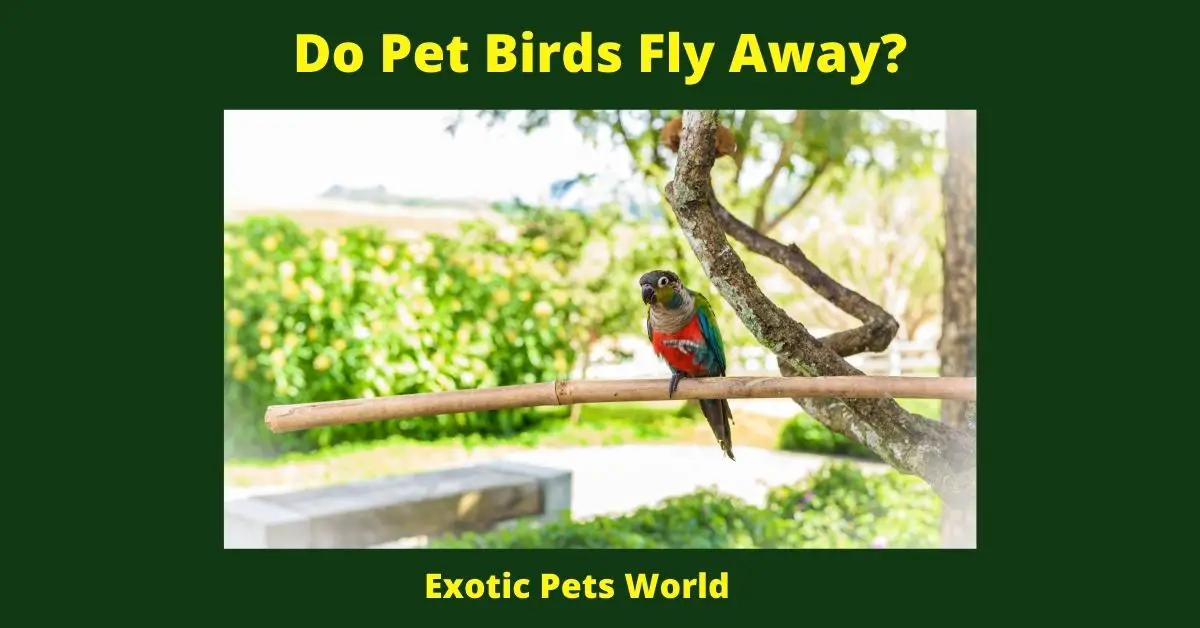There is a common misconception that all pet birds will fly away if they are not kept in a cage. This is not true! In fact, many pet birds enjoy being around their owners and will stay close by. There are some bird species, such as parrots, who are more likely to fly away than other types of birds, but even they can be trained to stay close to home
Do Pet Birds Fly Away?
Do pet birds fly away? The answer to this question may surprise you. Contrary to what you might think, pet birds do not always fly away when they have the opportunity. In fact, many pet birds choose to stay with their human families for the rest of their lives. There are a number of reasons why pet birds stay with their owners, and we will discuss some of them in this blog post. So if you’re wondering whether your bird will take flight at the first opportunity, read on!
Will all Pet Birds Fly away?
If you do have a pet bird who likes to fly away, there are several things you can do to help keep them from getting too far from home. One option is to install a bird feeder in your yard. This will give your bird a place to eat and drink that is close to home, which may help keep them from straying too far. You can also train your bird to come when you call them by using a special whistle or voice command. If you are consistent with these training techniques, your pet bird should start responding better and staying closer to home. Do Pet Birds Fly Away?

What Types of Pet Birds will Fly away if they get Chance?
While all pet birds may feel the desire to take flight if they get the chance, there are certain types of pet birds that are more likely to attempt an escape. These include parakeets, cockatiels, and lovebirds. If you have one of these types of pet birds, it is important to keep a close eye on them and make sure they don’t have any opportunity to escape.
- Parakeets – Parakeets are the most likely type of pet bird to try and fly away if they get the chance. They are small, fast, and agile, and can easily escape from a room if given the opportunity.
- Cockatiels – Cockatiels are also known for their love of flying. They are larger than parakeets, but still, have enough energy and agility to escape from a room if they get the chance.
- Lovebirds – Lovebirds are very active birds that love to explore their surroundings. They can be quite nimble when they want to be, and will often try to fly away if they get the chance.
- If you have one of these types of pet birds, it is important to keep a close eye on them and make sure they don’t have any opportunity to escape. Make sure your doors and windows are securely closed, and keep an eye on them when they are out of their cages. If you notice that your bird is trying to escape, try to give them some toys or activities to keep them occupied so they don’t get the chance to fly away.
What factors influence whether a pet bird will fly away from home or not?
There are a few key things that bird owners can do to help keep their pet birds from flying away.
- The most important is to make sure the bird’s wings are trimmed so it cannot fly. Birds that have been clipped will not be as motivated to try and fly away from home.
- Additionally, providing a safe and comfortable environment for the bird can help reduce its desire to fly away.
- Providing plenty of toys and perches, as well as a spacious cage, can help make the bird feel at ease in its surroundings.
- Finally, getting to know your bird and developing a close bond with it will also help keep it from flying away. When the bird feels like it has a strong connection with its owner, it will be less likely to
How to keep your pet bird from flying away?
- Trimming Your Birds wings – If you have a bird that you want to keep inside the house, it is important to talk with your vet and decide whether or not trimming their wings is right for them. It’s been proven that this can be good for birds as they will fly less often and will stay in one area more.
How to Trim your Pet Birds wings?
The steps to trimming your bird’s wings are as follows:
- Collect a towel and some scissors for cutting.
- Take the bird out of its cage, set it on a flat surface where there is no wind or breeze.
- Put the towel over their head so they cannot see what you’re doing, this will help to calm them down during the process.
- Carefully take one wing at a time from underneath then spread open all feathers until you reach the bottom feather layer which should be shorter than the rest (these are called primary flight feathers). If any longer than others cut off about half-inch length with scissors being careful not to nick flesh or bone but just tip of each feather itself; do both sides evenly so that neither side becomes heavier than the other.
- Once trimmed, release the bird and watch it fly away to test if it can still manage; probably will but just in case keep an eye on it for the next few days.
How often do I need to Trim My Pet Birds Wings?
A Birds Feathers are always growing so trimming your bird’s wings is an ongoing process. You should check them every couple of weeks or so and if they have grown too long, then it’s time to give another trim.
How Can I Train My Pet Bird Not to Fly away?
- Spending Time training your bird is key to having a well-behaved pet. There are a few different commands you can teach your bird, such as come, stay and perch. If your bird knows what is expected of it, it will be less likely to fly away in search of something new.
- Train Your Bird to Return to you. Starting inside and with the bird in a cage, teach him to come when called using his name or another word like “here.” Praise your bird for every return.
- Reward Returned Birds. If you are outside and notice that your bird has flown off, rewarding it for coming back will make it more likely that he will do so next time. Give treats as rewards if possible (but not sugary ones or anything fatty).
- Keep Your Bird In Sight. Often times birds fly away because they’re scared of something on the ground below them, such as cars driving by or people walking around without noticing them up above their heads! So keeping an eye out at all times makes sense here; especially since most pet birds know how high they can fly without getting into trouble with humans who might hurt them if they got too close.
- Introduce your Bird to New Places Slowly. If you take him out of his cage and place the bird on a table, he will soon grow accustomed to being there. After about an hour or so start moving around the room with him still perched at all times until finally opening up windows in other rooms where possible; this way won’t spook him when another door opens unexpectedly because he’s already used to seeing it from afar. This also helps keep birds from flying away due as well!
- After you have trained him indoors to return to you, you might want to go to a larger space like a park or a friend’s house. Just remember to take it slow and only go to places that you know your bird is comfortable with!
Get Your Bird an ID Tag.
This one is a must-have for all pet birds. If your bird does happen to fly away and gets lost, an ID tag will help someone return him safely back to you. Make sure the tag has your contact info on it!
What are The benefits of having a pet bird that stays at home?
Birds are great companions. They make wonderful pets and will keep you company when no one else is around! Having a bird at home can be very rewarding, but it takes work too. Here are some things to consider before deciding on adopting an avian friend:
- You must spend time with your bird every day – this means training them, playing games together as fetch or hide-and-seek; they need exercise so don’t forget about walks outside (if possible)! Feeding him nutritious food that contains all essential vitamins minerals he needs for good health so he doesn’t get sick easily either!
- A cage is needed as well since most species of birds do not travel well unless there’s plenty of room inside their habitat which means it should be large enough to fit all their essential needs including water bowls and perches too!
- You have been warned about this before but I will say again: Birds can be messy creatures that poop everywhere so think twice if a feathery friend won’t live up to your lifestyle because cleaning cages isn’t fun either.

What to do if your Pet Bird does Fly away?
If your pet bird does fly away, the best thing to do is to remain calm. Try and locate your bird by looking for it in trees or high places. If you can’t find your bird, make a loud noise to try and get its attention.
- Put Food out – your bird may see the food and come to it.
- Move Cage to outside – your bird may hear the familiar sounds of home and come back to it.
- Place Cage in a tree – this is very similar to moving cage outside but your bird has an easier time finding it if it gets tired or hungry while trying to find its way home.
- Search the neighborhood – ask neighbors if they have seen it and search in trees or on top of houses.
- Look for your pet bird’s favorite treat – this can help draw attention to where you are looking for him/her.
- Use a megaphone in case it is far away – your bird has a better chance of hearing you this way.
- Take a picture to show people and motorists – it may help if someone else sees them before you do because they are more likely than not going to see where it went when they look up from their driving.
- Post Flyers – put up flyers in the neighborhood with a picture of your bird and your contact information. You can also go online to different lost pet websites to post there as well.
Final Thoughts – Do Pet Birds Fly Away?
In conclusion, while all pet birds may not stay close to home naturally, there are many things you can do as an owner to encourage them to do so. With a little patience and effort, you can keep your feathered friend happy and safe within easy reach. Thanks for reading!


I like this site very much, Its a really nice billet to read and find info.Blog monry